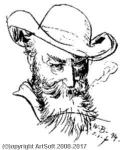Wilhelm Busch
Wilhelm Busch
Born: 1832
Death: 1908
Biography:
Heinrich Christian Wilhelm Busch was a German humorist, poet, illustrator and painter. He published comic illustrated cautionary tales from 1859, achieving his most notable works in the 1870s. Busch's illustrations used wood engraving, and later, zincography.
Busch drew on contemporary parochial and city life, satirizing Catholicism, Philistinism, strict religious morality and bigotry. His comic text was colourful and entertaining, using onomatopoeia, neologisms and other figures of speech, and led to some work being banned by the authorities.
Busch was influential in both poetry and illustration, and became a source for future generations of comic artists. The Katzenjammer Kids was inspired by Busch's Max and Moritz, one of a number of imitations produced in Germany and the United States. The Wilhelm Busch Prize and the Wilhelm Busch Museum help maintain his legacy. His 175th anniversary in 2007 was celebrated throughout Germany. Busch remains one of the most influential poets and artists in Western Europe.
In the late 18th century Johann Georg Kleine, Wilhelm Busch's maternal grandfather, settled in the small village of Wiedensahl. There, in 1817, he bought a thatched half-timbered house, where Wilhelm Busch was to be born about 15 years later. Amalie Kleine, Johann's wife and Wilhelm Busch's grandmother, kept a shop in which Busch's mother Henriette assisted while her two brothers attended high school. When Johann Georg Kleine died in 1820, his widow continued to run the shop with Henriette.
At the age of 19 Henriette Kleine married surgeon Friedrich Wilhelm Stümpe. Henriette became widowed at the age of 26, with her three children to Stümpe dying as infants. About 1830 Friedrich Wilhelm Busch, the illegitimate son of a farmer, settled in Wiedensahl after completing a business apprenticeship in the nearby village of Loccum. He took over the Kleine shop in Wiedensahl, which he completely modernised.
Wilhelm Busch was born on 15 April 1832, the first of seven children to the marriage of Henriette Kleine and Friedrich Wilhelm Busch. His six siblings followed shortly after: Fanny (1834), Gustav (1836), Adolf (1838), Otto (1841), Anna (1843) and Hermann (1845); all survived childhood. His parents were ambitious, hard-working and devout Protestants who later, despite becoming relatively prosperous, could not afford to educate all three sons. Busch's biographer Berndt W. Wessling suggested that Friedrich Wilhelm Busch invested heavily in his sons' education partly because his own illegitimacy held significant stigma in rural areas.
The young Wilhelm Busch was a tall child, but with a rather delicate and graceful physique. The coarse boyishness of his later protagonists "Max and Moritz" was rare in his childhood. He described himself in autobiographical sketches and letters as sensitive and timid, as someone who "carefully studied apprehension", and who reacted with fascination, compassion and distress when animals were killed in the autumn. He described the "transformation to sausage" as "dreadfully compelling", leaving a lasting impression; pork nauseated him throughout his life.
In the autumn of 1841, after the birth of his brother Otto, Busch's education was entrusted to the 35-year-old clergyman Georg Kleine, his maternal uncle at Ebergötzen, this probably through lack of space in the Busch family home, and his father's desire for a better education than the small local school could provide, where 100 children were taught within a space of 66 m2 (710 sq ft). The nearest convenient school was located in Bückeburg, 20 km (12 mi) from Wiedensahl. Kleine, with his wife Fanny Petri, lived in a rectory at Ebergötzen, while Busch was lodged with an unrelated family. Kleine and his wife were responsible and caring, exercised a substitute parental role, and provided refuge for him in future unsuccessful times.
Kleine's private lessons for Busch were also attended by Erich Bachmann, the son of a wealthy Ebergötzen miller. Both became friends, according to Busch the strongest friendship of his childhood. This friendship was echoed in the 1865 story Max and Moritz. A small pencil portrait by the 14-year-old Busch depicted Bachmann as a chubby, confident boy, and showed similarities with Max. Busch portrayed himself with a "cowlick", in the later "Moritzian" perky style.
Kleine was a philologist, his lessons not held in contemporary language, and it is not known for certain all subjects Busch and his friend were taught. Busch did learn elementary arithmetic from his uncle, although science lessons might have been more comprehensive, as Kleine, like many other clergymen, was a beekeeper, and published essays and textbooks on the subject — Busch demonstrated his knowledge of bee-keeping in his future stories. Drawing, and German and English poetry, were also taught by Kleine.
Busch had little contact with his natural parents during this period. At the time, the 165 km (103 mi) journey between Wiedensahl and Ebergötzen took three days by horse. His father visited Ebergötzen two to three times a year, while his mother stayed in Wiedensahl to look after the children. The 12-year-old Busch visited his family once; his mother at first did not recognize him. Some Busch biographers think that this early separation from his parents, especially from his mother, resulted in his eccentric bachelorhood. In the autumn of 1846, Busch moved with the Kleine's to Lüthorst, where, on 11 April 1847, he was confirmed.
More...
Wikipedia link: Click Here


